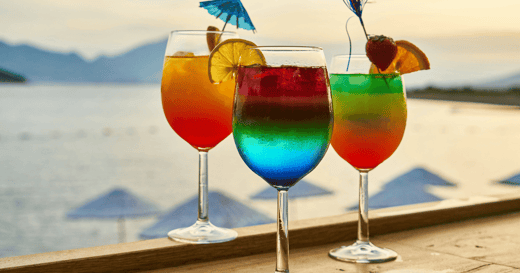Margins shape your liquor store’s success. Between rising supplier costs, power-hungry coolers, and products that expire before they sell, every category tells a different profit story.
Most stores average 20–30% gross profit overall, but that number hides the truth: Beer margins can dip below 30%, while spirits and wine can push past 40% when priced and managed strategically.
Knowing what drives those differences — and tracking them with the right tools — is how top-performing stores turn slim margins into steady growth.
Learn the biggest challenges to maintaining liquor store profit margins and how inventory management software can help you earn more on every sale.
Category-Specific Challenges in Liquor Retail
Beer, wine, and spirits have different handling, storage, and shrinkage costs that affect your liquor store’s profit margins. The most profitable stores recognize and manage those differences strategically.
Here’s how they affect operations in real time.
Wine: Managing Storage and Spoilage
Unlike spirits or beer, wine is highly sensitive to its environment. Temperatures above 55°F or low humidity can compromise quality, crack corks, and dull flavor.
Climate-controlled storage, dedicated shelving, and power consumption all add to overhead. Slow turnover compounds operating costs — every extra week means more refrigeration expense, less liquidity, and greater risk of inventory loss due to degradation and potential spoilage.
Spirits: Controlling Theft and Inventory
Premium spirits can be your most profitable category — and your most vulnerable. With markups as high as 55%, every missing bottle represents revenue loss. Strong security protocols and accurate inventory tracking are essential to protect those gains.
For example, a 1.75L bottle of Ketel One sells for around $38.99. Lose just a few each month to shrinkage, and you’re out thousands a year.
Beer: Covering Refrigeration and Waste
Beer may be your highest-volume seller, but it’s also one of the costliest to store. Coolers run nonstop, driving energy use, while bulky 24-packs and kegs consume valuable space. To protect margins, inventory must turnover quickly — temperature swings or missed rotation schedules can lead to spoilage and waste that erase profit.
Storewide Factors That Influence Liquor Store Profit Margins
Every liquor store runs on the same core variables — seasonal demand, supplier terms, shelf space, and pricing strategy. These factors ripple through every category, shaping what sells quickly, what ties up capital, and what earns the strongest margins.
As a liquor store owner, it’s essential to:
-
Follow seasonal buying trends: Stock more light beer for summer barbecues, bring in extra wine for the holidays, and load up on spirits ahead of big events like New Year’s Eve or football season.
-
Meet supplier minimums: Buy in bulk when contracts require full cases per category, like multiple wine varietals or full beer pallets.
-
Improve ROI through shelf placement: Give cooler doors to bestselling lagers and endcaps to crowd-pleasers like local pinot noir or popular whiskey brands that move quickly.
-
Analyze customer traffic patterns: Track when and where shoppers browse to match promotions and inventory to the times each category sells best.
-
Balance premium and value pricing: Offer entry-level brands and top-shelf labels within each category to capture impulse buyers and higher-spending regulars.
These patterns reveal which categories create lasting profit instead of surface-level revenue, and liquor store point of sale (POS) software is essential for capturing that insight.
Why Analytics-Focused Software Is Critical for Liquor Shops
Accurate category tracking is the foundation of margin growth. A data-driven POS system replaces guesswork with real-time reporting, turning daily sales activity into actionable insight.
With the right analytics, you can:
-
Track category performance: Use detailed sales reports to compare profit and volume across beer, wine, and spirits.
-
Monitor inventory movement: Run turnover analysis to identify expensive wine or slow-moving products that tie up cash.
-
Understand customer behavior: Review purchase patterns, from weekday beer runs to weekend wine splurges, to see which categories shoppers favor and plan smarter promotions.
-
Measure operating costs: Add refrigeration, storage, and security expenses by product type to estimate true profitability.
With real data at your fingertips, every decision becomes strategic. Your POS transforms daily operations into measurable actions that drive stronger margins and higher ROI.
Grow Your Liquor Store Profit Margins With Bottle POS
Bottle POS is purpose-built for liquor retailers. Its detailed, customizable analytics provide unmatched visibility into sales, profit margins, and inventory — giving you the insight to make smarter, faster, data-driven decisions.
This system gives you the ability to:
-
Rank products from A to D to flag your best and worst performers.
-
Track inventory in real time across every category.
-
Generate sales reports and in-depth analytics in seconds.
-
Access an extensive, liquor-specific SKU database that simplifies setup and updates.
-
Set custom pricing for case discounts, multi-bottle deals, and premium markups.
Bottle POS helps you see where your profit comes from and how to grow it faster.
Schedule a free demo to see how Bottle POS helps you increase liquor store profit margins per category, cut waste, and make data-backed decisions that grow your bottom line.
Get a customized quote from Kevin today.







 by Cort Ouzts
by Cort Ouzts

